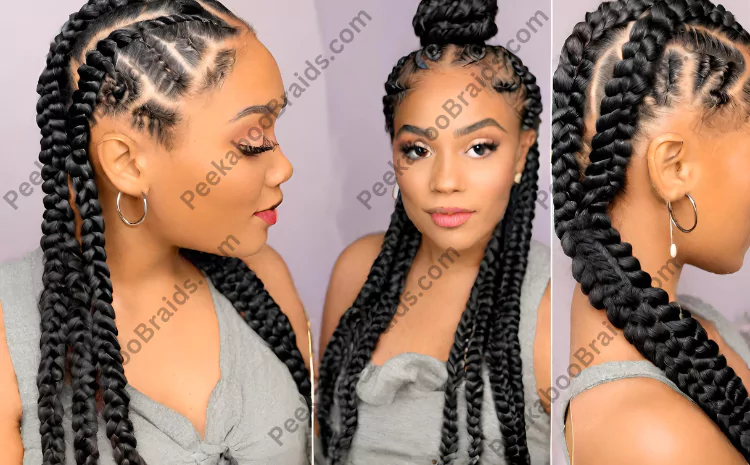Feed in braids have become a go-to protective hairstyle for achieving length and versatility without damaging natural hair. These braided styles involve taking your natural hair, dividing it into cornrows, and then “feeding in” hair extensions that are pre-braided. The result is gorgeous braids seamlessly blended with your natural hair.
Unlike sew-ins or wig installs, feed in braids don’t require glue or chemicals and are gentler on edges. You can create anything from flowing goddess braids to edgy ponytails or updos using this technique.
This guide will teach you everything you need to know about achieving flawless feed in braids, from choosing hair and parting techniques to maintaining your style. Let’s dive in!
Key Takeaways
- Feed in braids are a versatile protective style where natural hair is braided and attached to cornrows underneath
- You can create various looks from goddess and ponytail braids to creative patterns like hearts and zig zags
- Opt for jumbo, medium, or small straight back braids. Add curly ends for a boho vibe
- Feed in styles last 6-8 weeks. Moisturize hair and scalp beneath to minimize damage and growth issues
How to Do Feed In Braids?
Doing feed in braids is simpler than it looks. Here are the basic steps:
- Start with freshly washed and conditioned hair without products
- Create cornrows going straight back or in a U-shape on your head
- Take the pre-braided hair and attach it to the cornrows using a latch hook tool, working from back to front
- Dip the ends of the extensions in boiling hot water to seal the tips
- Style the braided hair as desired – leave straight, curl the ends, create a top knot, etc.
While you can DIY feed in braids at home, getting them professionally installed the first few times can help you learn techniques for tidy parts and proper braiding.
Feed In Braid Styles and Designs
The wonderful thing about feed in braids is all the versatility they provide. You can create anything from flowing mermaid braids to edgy geometric updos.
Goddess Feed In Braids
Goddess braids are the most popular feed in style. For these, have your stylist section out a curving side or middle part shape. Then, feed medium to large braids down your head in lines, leaving the ends slightly curly and loose.
Ponytail Feed In Braids
For a stylish look, have your feed in braids pulled up into a sleek high ponytail or bubbled pigtails. This style works great for athletes, busy moms, or girls on the go.
Creative Parts and Shapes
Get creative with your parts! Ask your stylist to section out hearts, triangles, squiggly lines, or words using the parts between your feed in braids.
You can also do creative braid shapes like zig zags, squiggles, or even a braided top knot.
Half Up Half Down Styles
If you don’t want all your hair braided, try a half up half down feed in style instead. This lets you rock gorgeous braids on top while leaving the back loose and curly.
Two Strand Twists
For a cool bohemian vibe, get chunky two strand twists fed into cornrows. You can leave these hanging straight or dip-dye the ends in a fun color.
Other Unique Styles
- Stacked braids
- Braided top knot
- Feeds ins on one side only
- Short bob length braids
Don’t be afraid to show your stylist inspiration pics and get creative with shape, height, color, and texture!
Feed In Braid Size, Length, and Type
Feed in braids let you customize everything from size to color and texture.
Braid Size
Jumbo braids are the largest option, with each braid being about the width of two fingers put together. Jumbos make a statement and create gorgeous volume.
Medium sized braids are the most popular, about the width of one finger. These blend seamlessly and move well.
Finally, small braids offer the most classic, old school box braids look.
Braid Length and End Style
Most feed in braid extensions come in lengths between 14 inches (shoulder length) and 30 inches (extra long). The most common is 20-22 inches.
You can also customize the ends by:
- Leaving straight
- Dipping in hot water to create curls or waves
- Adding synthetic curly hair extensions
- Wrapping with embroidery floss for a boho look
Type of Hair Extensions
The most popular extension types for feeds ins are:
- Kanekalon hair: Synthetic fiber that mimics the texture of African American hair; inexpensive
- Toyokalon hair: Softer synthetic with high sheen; smooth texture
- X-Pression pre-stretched braids: Easy to install; bouncy curl pattern
- Human hair: Blends most naturally; can customize exact curl and color
- Freetress Water Wave braids: Pre-braided wet and wavy human hair
Human hair blends most seamlessly while synthetic hair like Kanekalon offers vivid color options. Always opt for textures made specifically for braiding.
Use the comparison chart below to help select your extensions:
| Extension Type | Pros | Cons |
|---|---|---|
| Kanekalon | Vibrant colors, texture blends well | Can get frizzy over time |
| Toyokalon | Smooth and shiny | Limited coloring |
| X-Pression | Pre-stretched and easy to install | Synthetic shine |
| Human Hair | Blends perfectly, customizable | Most expensive |
| Freetress Water Wave | Gorgeous wet n’ wavy look | Needs frequent moisturizing |
How Long Do Feed In Braids Last?
With proper care, feed in braids can last 6-8 weeks or about 2 months.
Be sure to:
- Tie hair nightly with a satin scarf
- Moisturize braids and scalp 1-2 times per week
- Gently wash every 2 weeks with conditioner and braid spray
- Avoid heat styling daily
Don’t keep braids longer than 2 months since the extensions and your natural hair will start to loosen and look unkempt.
Maintaining Healthy Hair Beneath Feed Ins
While feed in braids are gentler than some protective styles, keeping them too long or not caring for your hair properly can still lead to breakage and thinning.
To keep your strands healthy and strong:
- Moisturize beneath braids 1-2 times per week with water-based products. Focus on the ends and scalp.
- Gently shampoo and condition braids every 2 weeks, using light, hydrating formulas free of sulfates and silicones.
- Avoid too much tension on edges when styling top-heavy looks like ponytails or buns.
- Take biotin supplements and collagen peptides to support thickness and growth
- Do not keep braids longer than 8 weeks maximum
Feed in braids don’t have to damage your hair – you just need to give strands TLC while rocking these stylish protective looks!

Hi there! I’m M.Afzal, a passionate and experienced hair stylist with a love for creating unique and trendsetting looks. With years of expertise in the industry, I’m dedicated to sharing top-notch advice and inspiring ideas to elevate your hairstyle game. Join me on this journey of beauty and self-expression as we explore the captivating world of peekaboo braids and much more!

